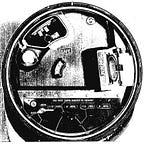New Airstrip Could Be Home to Hezbollah’s Drones
The base puts the militia’s drones close to Syria
by ADAM RAWNSLEY
The conflict in Syria has already played host to Iranian, Israeli, American and Syrian drones. Now a new report shows that another player is entering Syria’s drone war.
On April 23, IHS Jane’s published a report with satellite imagery suggesting that Lebanese Hezbollah had built a small air base capable of hosting unmanned aerial vehicles.
The airfield is in Lebanon’s Bekaa Valley, a stronghold for the terror group. The short size of the unpaved runway — just 670 meters long and 20 meters wide — led the publication to believe it’s intended as a UAV facility.
Jane’s used Iran Ababil-3 unarmed drones as a yardstick to show that two buildings built over two kilometers west of the runway could house the drones. It’s a good yardstick.
The Ababil-3 is one of Iran’s most exported UAVs. It’s also the model most often used by Syrian Pres. Bashar Al Assad’s regime. But a hangar that size could accommodate just about any Iranian drone.
Up until the war in Syria, Hezbollah used UAVs primarily in Israel. Sometimes it loaded the drones with explosives and crashed them into targets, making the UAV a crude cruise missile.
More often, Hezbollah buzzed the drones near Israeli air defenses and then used the footage in propaganda videos or during speeches.
But IHS Jane’s report shows that the group is expanding its use of drones to include more traditional support for ground forces along the Syrian border.
Iranian hardware has been at the center of Hezbollah’s drone operations since the organization first began using them against Israel. In November 2004 and April 2005, Hezbollah UAVs dubbed “Mersad-1” flew over the Israeli border and back.
Reports differ on whether the Mirsad was from the Ababil or Mohajer family of Iranian drones. But the Misrad UAV Hezbollah showed off after the incidents is closer to an early Ababil than a Mohajer.
The terror group initially claimed that it had received eight of the aircraft from Iran. But a classified State Department cable to the U.S. embassy in Beirut has more info.
According to the cable, Hezbollah had only one operational Misrad in 2005. That’s down from three. It lost one when the drone crashed during landing. The other was defective and never flew.
By the time of the 2006 Israel-Hezbollah war, Israeli defense officials estimated that Hezbollah had around a dozen drones. The war offered the first up-close look at Hezbollah’s UAVs when Israeli fighter jets shot down two. They were similar to the Ababil-II generation of Iranian drones.
In 2012, Hezbollah lost another drone — dubbed “Ayoub” — to Israeli jets when it flew over Israel. In a later speech, Hezbollah leader Hassan Nasrallah admitted the drone had come from Iran.
The Lebanese media later reported that the drone contained parts illicitly obtained from Germany by an IRGC front company — a common practice Iran uses to supply its UAV production.
By 2013, Israeli estimated Hezbollah’s UAV fleet was down to 10. That year, Israeli troops soldiers shot down another suspected Hezbollah drone off the coast of Lebanon. The group denied it owned the aircraft.
Since then, information about Hezbollah’s UAV operations and inventories has been hard to come by. But it’s a good bet that any drone operations from the Bekaa airstrip will have more to do with the conflict in Syria than Hezbollah’s traditional unmanned antagonism of Israel.
First, the Israeli Air Force enjoys overwhelming air superiority in the region. Israel would likely crater the readily identifiable airstrip during any major conflict between it and Hezbollah.
Second, the location of the airfield in northern Lebanon cuts off a lot of options for potential drone pilots. The Iranian drones that make up Hezbollah’s known arsenal lack satellite communications, which limits their drones’ range.
Using the Ababil-3 as a yardstick again, the listed range of roughly 100 kilometers places it outside line-of-sight control to attack Israel.
Ayoub’s 2012 flight was the longest known flight of a Hezbollah UAV over Israel to date. It took off from southern Lebanon. It’s hard to imagine Hezbollah using this airstrip to launch drones into Israel.
But Hezbollah has been tending to other — more urgent — priorities close to the strip’s location. The group’s fighters have been deeply involved in the fight to put down the insurgency against its allies in the Assad regime.
As part of that support, Hezbollah has fought along both sides of the Lebanon and Syria border in towns such as Arsal and near the mountains in Qalamoun. It’s helping to preserve the regime’s supply lines and keep jihadists active in the area from spilling over the border.
IHS Jane’s spoke to Hezbollah sources who stated that the group is using drones to support its ground troops fighting in the Qalamoun mountains.
The Syrian military has used drones for similar operations in the area, releasing footage taken by an Iranian Mohajer-4 guiding artillery strikes onto insurgent arms caches in the mountains there.
In September 2014, Iranian and Hezbollah-allied media outlets also published two videos purporting to show missile strikes against Jabhat Al Nusra jihadists allegedly carried out by Hezbollah drones.
Despite much hand wringing that the incident could represent a terrorist group’s first lethal use of a drone in combat, no evidence confirming the strike has yet surfaced.
Nor is Hezbollah the only military force interested in keeping an eye on that border. U.S. Special Operations Command is now reportedly working with Lebanon’s armed forces to fly Aerosonde Mk 4.7 UAVs out of Hamat Air Base on the Mediterranean coast.
There’s a pretty clear reason for that — the U.S. wants to track the movements of jihadist groups such as Islamic State and Jabhat Al Nusra.
